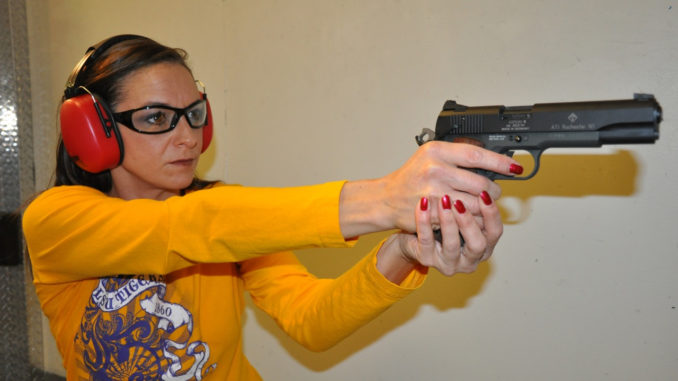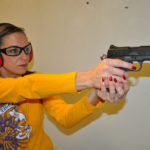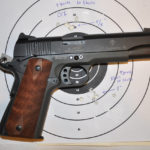
The GSG M1900 .22 LS
An old chestnut states “Beware the man with one gun.”
The premise is, if a man has only one gun, he’s going to do all his shooting with just that gun, and he might well be able to outshoot you.
I remember as a young man buying a Marlin .22 WMR (.22 Magnum) because I wanted the reach and extra power that cartridge afforded.
And I was very enamored of Marlin’s “Micro-Groove” rifling. So rather than buy a nice semi-auto in that caliber, I bought a bolt action. After all, I hunted with centerfire bolt rifles. If I was going to be that guy you should beware of, I needed to buy a bolt.
That day, as they say, I should have stood in bed.
I still have the rifle, and have wished for years that my choice would’ve been a semi-automatic.
The gun is exceptionally accurate, but I suspect the semi-auto would have equaled it, and I would use the gun more — I just never liked the clunky feel of the bolt action in that rifle.
But there is a lot to be said for practicing with similar guns, particularly in the area of competitive and self-defense shooting.
I am on the verge of getting very heavily back into reloading. After doing some quick mental computations on bulk-pack centerfire pistol ammo in a local chain, I was stunned.
I guess I haven’t really paid a lot of attention to the fact that every time you shoot one of those cheap bulk pack bullets in .45 ACP, you are sending some $.35 down range. .40 S&W can cost you more than a quarter every time you pull the trigger. Even 9MM will ruin two dimes every shot.
No doubt about it, ammo is expensive — and if you practice for competition or simply practice a lot, either you reload, or you spend lots of dough.
Or you shoot a .22 Long Rifle handgun. .22 ammo is still the best deal on the market.
I was loaned an interesting handgun that has been on the American market for over a year.
Pat Blake of Accurate Firearms (www.accuratefirearms.com) practically bugged me until I came by his store and let him force his newest acquisition on me
“You gotta shoot this thing,” he kept telling me.
It is the GSG (German Sport Guns) M1911 .22LR.
The GSG line is imported by American Tactical Imports, Inc. (www.americantactical.us).
The company is a German gun manufacturer specializing in copying popular firearms and designing them in .22LR. This is their latest invention, and Blake was right. It is a lot of fun.
The company claims 80 percent interchangeability with mil-spec 1911 parts. The gun looks, feels and carries like John M. Browning’s iconic Model 1911 — except it’s a heck of a lot cheaper to shoot.
These are attractive and well-made guns — and at first glance, unless you look at that itty-bitty hole coming out of the end of the muzzle, you’d swear it was a standard 5-inch barreled 1911 — with a large beavertail, a skeletonized trigger and attractive wood grips.
The company website states the gun is “improved” to meet modern safety requirements, which means it has added to the design a magazine disconnect (the gun will not fire with the magazine removed), a drop safety and a firing pin block.
The brochure states the gun is designed to be used with high-speed .22 ammo — standard velocity and target ammo might not cycle the action — but several reviews on gun forums indicated little problems feeding standard velocity ammo.
The gun also has several unusual and innovative features not generally found factory ready — particularly in a handgun with a suggested retail of only $369.95.
Each GSG Model 1911 .22 LR comes with a threaded barrel to attach a suppressor. This will excite the silencer crowd — you don’t have to go aftermarket to buy a threaded barrel. GSG builds it into the gun, and has a special cover over the threads to protect them. A special wrench is included in the box allowing you to remove the thread guard and screw on a suppressor.
Another unusual feature is the sighting system. GSG uses the very effective three-dot sighting system for aiming. The rear site is drifted into a dovetail for windage, and locks down with an Allen screw.
The front sights (three are supplied) are different heights, and used to adjust elevation. The front sight is also drifted into a dovetail, and locked down with a supplied Allen wrench.
Blake told me he got his best groups from CCI Mini-Mag hollowpoints. While I didn’t have hollowpoints, I had Mini-Mag solids, and truthfully, could not see much improvement at 7 yards off a rest than with cheap Remington bulk ammo. Both shot ragged holes under 1 inch at 7 yards with a couple of fliers. I am sure this could be greatly improved by experimenting with different ammo.
Checking the gun forums, the overall reviews are very favorable toward the gun with most shooters commenting the accuracy was more than adequate. The guns seemed to feed reliably with most standard and high-speed .22 ammo, and did very well once the gun was broken in after a couple hundred rounds.
I found the gun attractive and comfortable to shoot, and get out of your mind this is a 1911 knock-off or copy — it is a 1911 in .22 caliber. A young lady student of mine tried the gun out and enjoyed it immensely. She is slight of build, and found the gun easy to shoot — in fact, she wanted to keep shooting it, but I had to end the session due to a previous engagement.
.22 conversion kits for 1911s have been on the market for decades — allowing aficionados of that design to shoot more and cheaper. And there have been other manufacturers’ models of the 1911 in .22LR on the market. Kimber has offered a version for years — it is all steel, I am sure much more of a purist’s gun, and the MSRP is more than twice as high as the suggested price of the GSG.
But finding a gun like this (prices ran on the internet from under $300 to the MSRP of $369) at this price is a treat. Manufacture is of steel, aluminum and a zinc alloy in the frame, which keeps weight and cost down.
It is reasonably priced, shoots great, and feels just like a 1911. What’s not to like about it?




